|
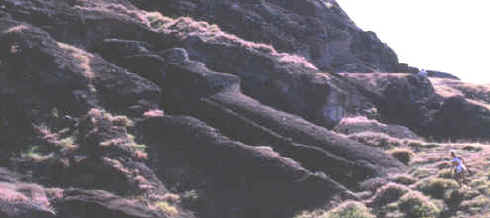
HUNDREDS OF STATUES LAY UNFINISHED
IN THE QUARRIES
EASTER ISLAND
PICTURE CREDIT GEORGE
FRISON
About 230 statues were actually moved from the quarries to platforms along
the coast six or more miles away. Platforms held up to 15 statues in a row
that were 6 to 33 feet tall with the largest ones weighing up to 82 tons.
There are 394 statues still attached in the quarry at every stage of
manufacture. They lay in all angles and heights on the rock face. Another
200 or more were left on the ancient roads between the quarry and the
coast as if everything came to a halt all of a sudden.
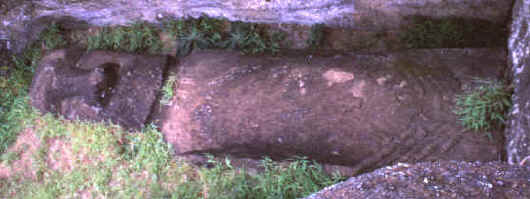
CLICK ON
PICTURE FOR LARGE IMAGE
A NICELY CARVED STATUE STILL LAYING
IN THE QUARRY
EASTER ISLAND
PICTURE CREDIT GEORGE
FRISON
Ancestor worship was quite common in one form or another within
prehistoric cultures around the world. It has been suggested that
these statues were ancestor figures. They are carved in a human form with
very angular eyes, noses and chins and some have elongated ears with ear
spools. The bodies have no legs and end at the abdomen. Arms
are carved down the sides with long fingers that meet across the lower
body in what has been described as a stylized loin cloth.
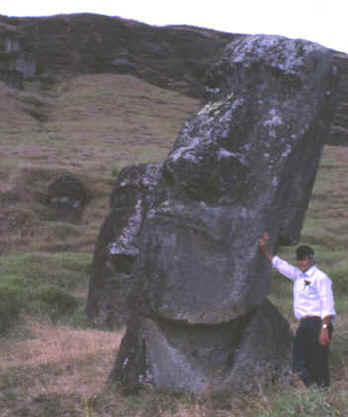
CLICK ON
PICTURE FOR LARGE IMAGE
BURIED STATUES NEAR THE QUARRY SITE
EASTER ISLAND
PICTURE CREDIT GEORGE
FRISON
Large numbers of statues lay partially buried not far from the quarry
where they were made. The soil has accumulated around them from 500
years of wind blown particles of rock and dirt raining down from the
heights above.
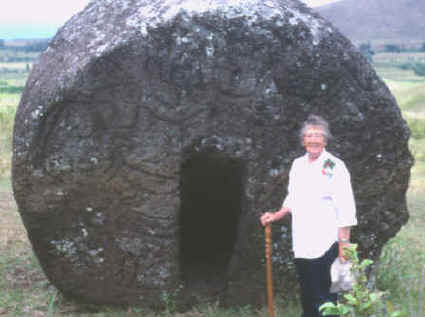
CLICK ON
PICTURE FOR LARGE IMAGE
TOP KNOTS CALLED "HA'U MOAI"
WERE PLACED ON STATUES
EASTER ISLAND
PICTURE CREDIT GEORGE
FRISON
Approximately 58 top knots once rested on top of statues. This added embellishment
may have began late in the statue building phase. They were made of red
scoria quarried from Puna Pau located several miles southeast of the
statue quarry Rano Raraku. Some had intricate carving on them with notches
cut into the bottom that fit onto the top of a statue as the
example in this picture shows. Some of these top knots measure up to 6
feet high and 7 feet in diameter with an estimated weight of 11 tons!
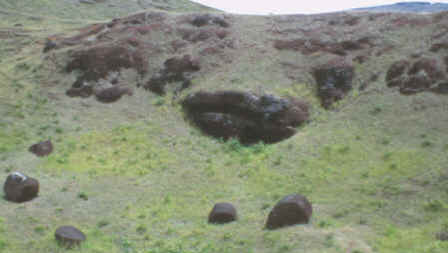
TOP KNOTS CALLED "HA'U MOAI"
LAYING NEAR THE QUARRY SITE
EASTER ISLAND
PICTURE CREDIT GEORGE
FRISON
About 25 more top knots still lay in or near the quarry where they were
carved.
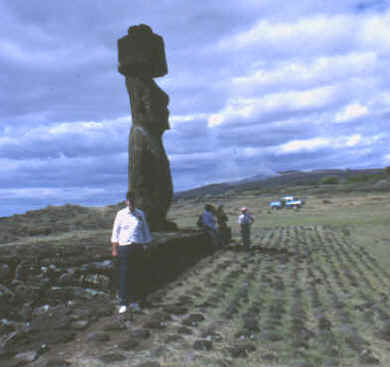
CLICK ON
PICTURE FOR LARGE IMAGE
A RESTORED STATUE WITH ITS ORIGINAL
TOP KNOT
EASTER ISLAND
PICTURE CREDIT GEORGE
FRISON
This statue was restored to its original platform ("ahu") with
a top knot.
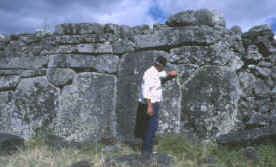
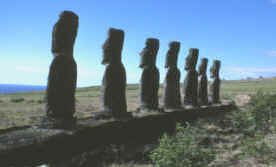
CLICK ON
PICTURES FOR LARGE IMAGE
EASTER ISLANDERS WERE SKILLED
STONE MASONS
PLATFORM STONES WERE FITTED TIGHTLY TOGETHER
EASTER ISLAND
PICTURE CREDIT GEORGE
FRISON
Some of the stone platforms became quite large during the later phase of
statue building. They were as large as 500 feet long and 10 feet high.
Stones used in their construction weigh as much as 10 tons.
All of the energy expended during the second phase for
monument building would have taken a fairly large number of people. The
peak population estimates occur between A.D. 1200 to 1500. Different
sources have figured the number somewhere between 7,000 to 20,000 people.
But it seems likely that the number never reach more than 10,000. Which
was too many for an island of this size and available resources.
FINAL
PHASE
STATUE BUILDING ENDS
FIGHTING AND THE BIRDMAN CULT BEGINS
A.D. 1500---

STATUES LONG AGO PUSHED OFF THEIR
PLATFORMS
EASTER ISLAND
PICTURE CREDIT GEORGE
FRISON
When the island's ecosystem changed so much that it became difficult to
obtain food and materials to construct platforms & setup statues the
people developed a new religion.
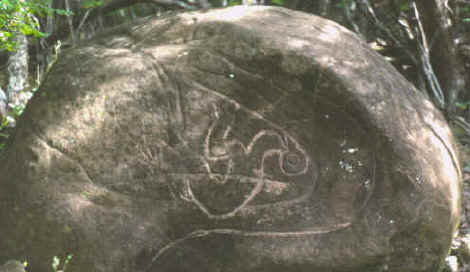
CLICK ON
PICTURE FOR LARGE IMAGE
THE BIRDMAN CULT---THE BEGINNING OF
THE END
EASTER ISLAND
PICTURE CREDIT GEORGE
FRISON
This period marks the beginning of a very sad future for the Easter
Islanders. Ancestor worship ends and is replaced by a religion featuring a
warrior elite. This picture shows one of the many squatting birdman
petroglyphs carved on boulders.
It's a logo of sorts that symbolizes the new direction the culture has
taken.
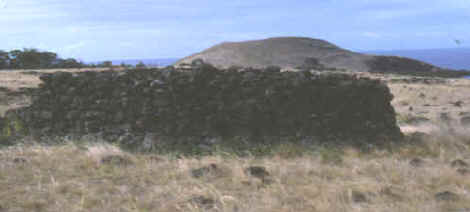
FORTIFIED STONE CHICKEN HOUSE
EASTER ISLAND
PICTURE CREDIT GEORGE
FRISON
For most of Easter Island's history the sole domestic animal was the
chicken. During the final phase they became the most valuable source of
protein and were very valuable. This picture shows one of the surviving
fortified stone chicken houses on the island.
By 1500 the people on Easter Island had killed off every species
of land bird and over half of the islands seabird species. The shellfish had
become overexploited and trees were no longer available to build canoes large
enough to hunt porpoise and this food source abruptly disappears from their
diet. It seems inevitable at this point that they would turn to humans as a
food source and this is what the archaeological record shows. Human bones
become quite common in the late Easter Island garbage heaps. Oral tradition
mentions an inflammatory taunt that suggests a time of cannibalism "the
flesh of your mother sticks between my teeth"!
|










